Top 10 Buddhist Grottoes in China
China is a country endowed with profound Buddhism culture. Especially along the ancient Silk Road, there are many incredible Buddhist grottoes throughout China’s history. The fabulous statues and eye-dazzling mural paintings are just sparkling gems that mirror the religious and cultural abundance of the country. Here below list ten most visited Buddhist grottoes and caves all over China.
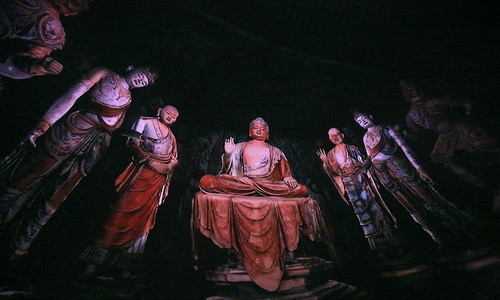
Perched on Chinese ancient Silk Road, Mogao Grottoes Cave is one of the most brilliant and best-known grottoes of Buddhism art in China. With a long-standing history dating back to 366 AD, the caves were firstly constructed with donations from wealthy caravan traders and merchants living by the Silk Road. Expanded through the dynasties, Mogao Grottoes has span for 1.6 kilometers long. Now it houses 735 carves and more than 2,400 fascinating clay statues as well as marvelous murals covering 45,000 square meters. The colored clay statues are in drastic sizes. The highest one reaches up to 35.6 meters, while the tiniest one is as short as two centimeters. The fabulous murals on the sidewalls and ceilings are the most remarkable highlights of the cave, depicting all walks of life and activities in a native setting. As the largest and richest extant treasure house of Buddhist art of China, it has been listed as the World Cultural Heritage Sites by the UNESCO in 1987.
Located about 12km south of Luoyang City, Henan Province, Longmen Grottoes complex is one of the four greatest grottoes in China. Different from Mogao Caves, all the statues are carved out of the hill cliff. The carving work started in Wei dynasty of the 5th century when the capital city was moved from Datong (home of Yungang Grottoes) to Luoyang. It was also the period when Chinese Buddhism reached its climax by gaining great support from ruler of the country.
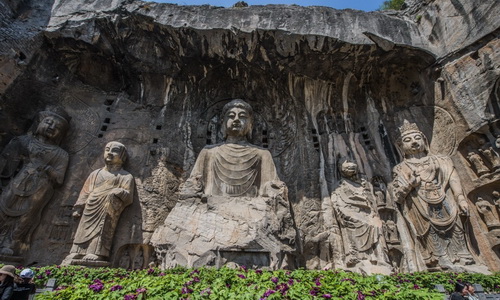
Throughout 500 years' expansion, Longmen Grottoes boasts an overwhelming number of statues up to 97,000. There are also over 2100 niches, 40 pagodas and 3,600 tablets and steles remained in the cave. The grottoes are mainly scattered on two Hills, namely West Hill and Longmen Hill. The West Hill part is the core area where the biggest statues are perched. Longmen Grottoes are now conveniently connected by high-speed trains from Beijing and Xian if considering a trip linking them through.
Situated about 16 km southwest of Datong City in Shanxi province, Yungang Grottoes is a shining World Cultural Heritage site famous for its highest achievement of stone carving in 5th century. Most of the extant grottoes were built during 460-525 AD in the Northern Wei dynasty when Buddhism was exceedingly popular in ancient China. The construction work was mostly financed by imperial rulers and noble families. Massive labors and intelligence were devoted into the elaborate carving works. Yungang Grottoes are blessed with a total number of 53 grottoes made up of more than 51,000 Buddha statues and statuettes. These statues vary from the tallest of 17 meters to the shortest of a few centimeters high, and some still retains their original color after thousands of years. The most notable highlight of the grottoes is the statues' mix styles of China, India, Persia and other western countries.
Located southeast of Tianshui City, Gansu Province, Maijishan Grottoes is nestled on Maiji Hill surrounded by lush green mountains. It boasts some of the most wonderful Buddhist rock carvings along the Silk Road. There are 194 existing caves and over 7,800 Buddhist sculptures as well as more than 1,000 square meters’ frescos that could date back to Northern Wei and Zhou dynasties (386–581 AD). The sculptures were linked through by winding walkways clinging to the sheer cliff, which allows visitors to go sightseeing in a vertical ascent and venture into the caves for further exploration. Tianshui, the home of Maijishan Grottoes, could be easily accessed by high-speed trains from Xian, Lanzhou and Zhangye. If you do not have more time for Mogao Caves, you could make a side trip to Maijishan.
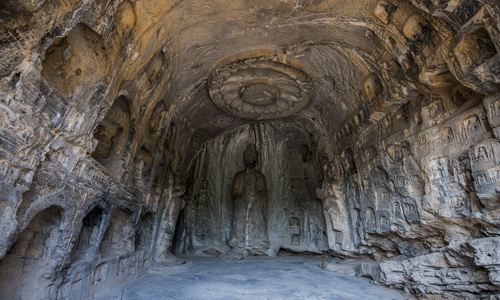
Located in the west suburb of Chongqing City, Dazu County is famed as Home of Rock Carvings in China. Dazu hosts forty sites of the world-renowned rock carvings, including more than 60,000 Buddhist statues that date back to the 7th to the 13th century. The grottoes is characterized by its artistic and exquisite demonstration of rock carving skills as well as the harmonious synthesis of Buddhism, Taoism and Confucianism. The rock carvings are mainly scattered in five parts along the steep hills, including Baodingshan, Beishan, Nanshan, Shizhuanshan, and Shimensan, among which the Baodingshan is the most spectacular site displaying the most colorful and exquisite statues. Listed as an UNESCO World Heritage site in 1999, Dazu Rock Carvings deserves your consideration when planning a Yangtze cruise from Chongqing.
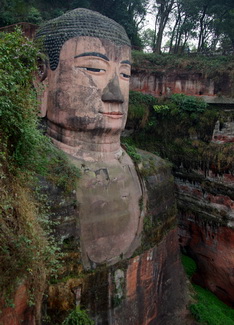
Not far from the city of Chengdu in Sichuan Province, Leshan Giant Buddha is the largest Maitreya Buddha statue in the world with an incredible height of 71 meters (233 feet). Carved out of an entire cliff, the 1,300-years-old Buddha statue is sitting in the open air and gazing across the river with heavy-lidded eyes, with his hands resting on his knees. The whole sculpturing work took about 90 years to complete, while many visitors might wonder why the statue is still well kept. In fact, there is a delicate and invisible drainage system hidden in the Buddha's hair, collar, chest and ears to prevent the Buddha from serious erosion and weathering. The best way to stare in awe of the Buddha’s full view is to take a ferry in front of it. Hiking lovers could take a couple of hours to ascend to the location of the Buddha head and trek down and up for a circle.
Bingling Thousand-Buddha Caves, aka Bingling Grottoes, are a famous religious attraction hidden in Yongjing County of Lanzhou. First built in 420AD, Bingling Temple grottoes were sculptured out of a 2km-long sheer sandstone cliff. In total, there are 183 niches, 694 stone statues, and 82 clay sculptures that remain in good condition now. During Yuan Dynasty (1271-1368 AD), the grottoes were deeply influenced by the Tibetan Buddhism. That's why we could see different styles of Buddha images. There are lofty walkways leaning against the face of the precipitous cliff for visitors to ascend for a close-up view. Less known to outsiders, Bingling Temple grottoes can be only accessed by a boat trip via Liujiaxia Reservoir, which is also a good way to absorb the serene vicinity of the grottoes.
Located in Sunan Yugur autonomous county, about 70 km from Zhangye city, Mati Temple, also known as the Horse’s Hoof, is a Buddhist temple complex made up of thousands of grottos that are embedded inside the cliff in an impressive manner. It is less of a temple in the traditional sense. Sheer rock walls are riddled with holes, niches and caves, with little wooden pavilions clinging miraculously to the cliff. The pagoda-shaped temple climbs up over 60 meters and boasts 7 floors consisting of 21 grottoes in total. The interior of the cliff has been carved into a labyrinth of tunnels, steps, and shrines, among which stand 200 Buddha statues carved over hundreds of years. Visitors may need to do a lot of crawling, climbing, and sometimes wriggling to explore the temple.
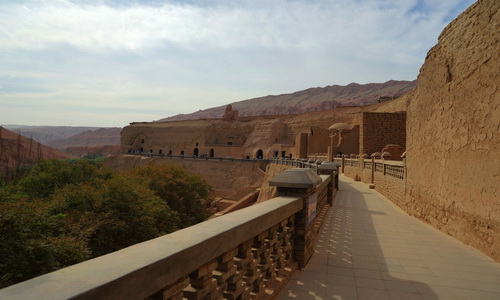
As another religious wonder on Silk Road, Bezeklik Thousand Buddha Caves in Turpan is a massive complex of Buddhist cave grottos dating from the 5th to 14th century. Near the ruins of old Gaochang Kingdom, Bezeklik is perched high clinging to the cliffs of the famous Flaming Mountains by showcasing a large number of shrines of carvings, sculptures and fresco paintings. There are 57 extant rock-cut caves in total, while the most eye-catching part is their ceilings with elegant murals of Buddha images and stories. Turpan used to be one of the most important trading center on the Silk Road, while Bezeklik Thousand Buddha Caves became the most popular destination of Buddhist pilgrimage.
Feilai Peak Buddhist Grottoes is one of the most wonderful sites in Hangzhou, which is worth your exploration for 2-3 hours together with a visit to Lingyin Temple. The 168-meter-tall Feilai Peak is located near Lingyin Temple, featuring a craggy limestone formation with more than 470 stone carvings of Buddha statues between the 10th and 14th centuries. Most of the grottoes were made in the periods ranging from Song to Yuan Dynasties (960 – 1368AD). Although the stone carvings on Feilai Peak is not as massive as Mogao Caves and Longmen Caves, it is closely related to the Linyin Temple, one of the largest and wealthiest Buddhist temples in China. Besides, its easy accessibility makes it a must-see for a side trip from Shanghai to Hangzhou.
Since most Buddhist caves are clinging to the silk route, explorers could embark on an epic trace tour of the Ancient Silk Road to check out os the essence grotto arts of China.









